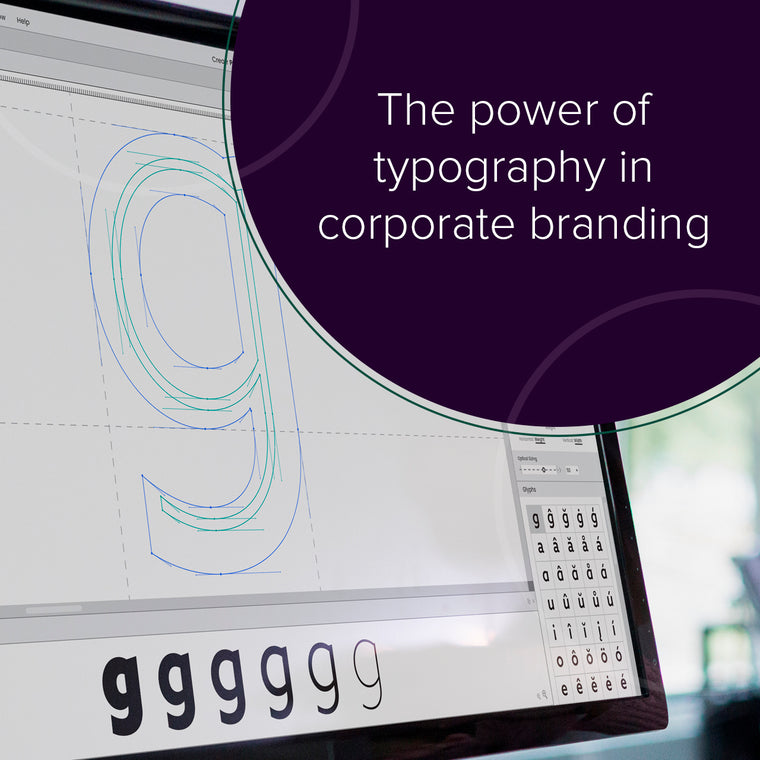The Power of Typography in Corporate Branding
In business, where making a lasting first impression is more crucial than ever, the role of typography in corporate branding is paramount.

Far from being just a mere arrangement of letters and words, typography emerges as a formidable tool in conveying a brand's essence, carving out a distinct identity, and building rapport with the intended audience.
It’s not just about the font you choose, it’s about the message it delivers. Delving deeper, typography's power extends to its ability to evoke specific emotions and cultural associations, making it an indispensable part of a brand's strategy. Typography does more than catch the eye, it resonates with audiences, shaping perceptions and significantly contributing to a brand's success. As we explore the impact of typography, we'll also look at how understanding the nuances of kerning, leading, and font choice can enhance your brand's message, ensuring it aligns perfectly with your corporate identity and values.
Why is typography important for a business?
Brand Personality and Identity
Typography stands as a pivotal component in sculpting a brand's personality. The choice of typeface, encompassing style, size, and even the nuances of character spacing, speaks volumes. It’s a visual language that articulates a brand's ethos - be it modern and cutting-edge, traditional and dependable, or playful and inventive. Consider how a serif font, often seen as classic and trustworthy, contrasts with the clean, minimalistic appeal of a sans-serif font.
The intricacies of typography, from the subtlest curve of a letter to the deliberate spacing between characters (known as kerning), collectively forge a brand’s visual identity. The thickness of lines, for instance, can communicate strength or delicacy, impacting the viewer's perception at a subconscious level.
Furthermore, understanding the psychological effects of these typographic choices is crucial. For instance, a bold, imposing font might evoke feelings of authority, while a handwritten-style font might feel more intimate and personal. Lastly, for brands with a global presence, being mindful of typography’s cultural implications is essential. What resonates in one culture might not translate effectively in another.
Consistency Across Platforms
Corporate branding extends well beyond traditional mediums like logos and business cards to include websites, social media, and packaging, making consistent typography a cornerstone of a unified brand presence. The harmonious use of typefaces, font sizes, and styles across these varied platforms is not just about aesthetic appeal, it's about forging a recognisable and memorable brand image. This uniformity is pivotal in enhancing brand recall, instilling a sense of reliability, and projecting professionalism.
Consider the challenge of responsive typography, which ensures that your brand's voice remains consistent whether seen on a magazine advert or a smartphone screen. Leading brands such as Apple exemplify this seamless transition across mediums, reinforcing their identity in the consumer's mind.
However, maintaining this consistency is not without its challenges, especially with the varying requirements of different platforms to ensure your brand's typographic language remains coherent and impactful.
Readability and Communication
At the core of successful branding lies effective communication, where the readability of text is not just an element, but a necessity. The selection and arrangement of fonts play a critical role in making information easily digestible. Whether it’s the crisp clarity on a website, the legibility on a product label, or the inviting layout of a marketing brochure, typography is instrumental in guiding readers through content and enhancing comprehension.
But readability extends beyond just choosing a clear font. It involves understanding the nuances between digital and print mediums - like how certain fonts perform better on screen than on paper.
An often overlooked yet crucial aspect is the accessibility of typography. Ensuring that text is legible for people with visual impairments not only broadens your audience but also reflects positively on your brand's inclusivity.
This knowledge can empower brands to harness typography not just as a design element, but as a powerful tool for clear and effective brand communication.
Differentiation in a Crowded Market
In a competitive marketplace, where countless brands vie for consumer attention, standing out is essential. Typography emerges as a strategic tool in this quest for differentiation. A unique, well-chosen typeface can elevate a brand, granting it instant recognition.
The power of typography in differentiating a brand also lies in its ability to reflect the brand’s core values and mission. A brand that champions sustainability, for example, might opt for a typeface that resonates with this ethos, subtly conveying its principles through design.
Furthermore, understanding the psychological underpinnings of typography can transform a typeface into an emotional anchor for consumers. Certain fonts can evoke feelings of trust, excitement, or comfort, thereby creating a deeper emotional bond with the brand.
Adaptability to Trends and Evolution
Typography is an ever-evolving art form, mirroring the shifts in design trends and societal changes. For brands, adaptability in this landscape is key to maintaining relevance and appealing to a dynamic audience. This flexibility allows brands to periodically refresh their image, staying in sync with the pulse of the time without the need for a complete rebranding.
The challenge lies in striking a harmonious balance between a brand’s enduring identity and the ever-changing typographic trends. Historical shifts in typography, from the bold fonts of the Art Deco era to the minimalist approach of the digital age, offer valuable lessons on how brands have navigated these changes.
On digital platforms, advancements such as web fonts and screen-optimised typography have revolutionised how brands adapt online. This evolution is not just about aesthetics but also functionality, ensuring readability and engagement in a digital-first world.
Moreover, understanding consumer behaviour is crucial in this adaptation. The rise of social media, cultural movements, and generational preferences significantly influence typographic trends. Brands that keenly observe and respond to these shifts can seamlessly align their typography with contemporary consumer expectations.
Conclusion
Typography is far more than just a design element. It is a strategic tool that plays a crucial role in shaping brand identity, fostering brand recognition, and ensuring effective communication. From creating a distinct personality in a crowded market to adapting to evolving trends and maintaining readability across various platforms, typography is an integral part of a brand's narrative.
This journey through the nuances of typography has underscored its significance in the corporate branding landscape. The right choice of typeface, the careful consideration of kerning and leading, and the adaptability to cultural and digital shifts are strategic decisions that impact a brand's perception and success.
As brands navigate the ever-changing terrain of consumer preferences and digital landscapes, the importance of typography will only continue to grow. It's a blend of art and science, where creativity meets strategy, creating a unique voice for brands in a global marketplace.
In this digital era, where attention is fleeting, and competition is fierce, understanding and leveraging the power of typography can be the difference between blending in and standing out. It’s a silent communicator that speaks volumes, a subtle yet powerful force that can elevate a brand from ordinary to extraordinary.
CONTACT
Ready to elevate your brand's impact through strategic typography and compelling design?
Absolute Design, an award-winning branding and graphic design agency based in Nottingham, is here to transform your vision into reality. Our expertise in creating visually stunning and strategically effective designs sets us apart. Let's collaborate to make your brand's story not just heard, but seen and remembered.

Enter your email address to sign up to our newsletter, featuring case studies, insights, industry news and much more.
